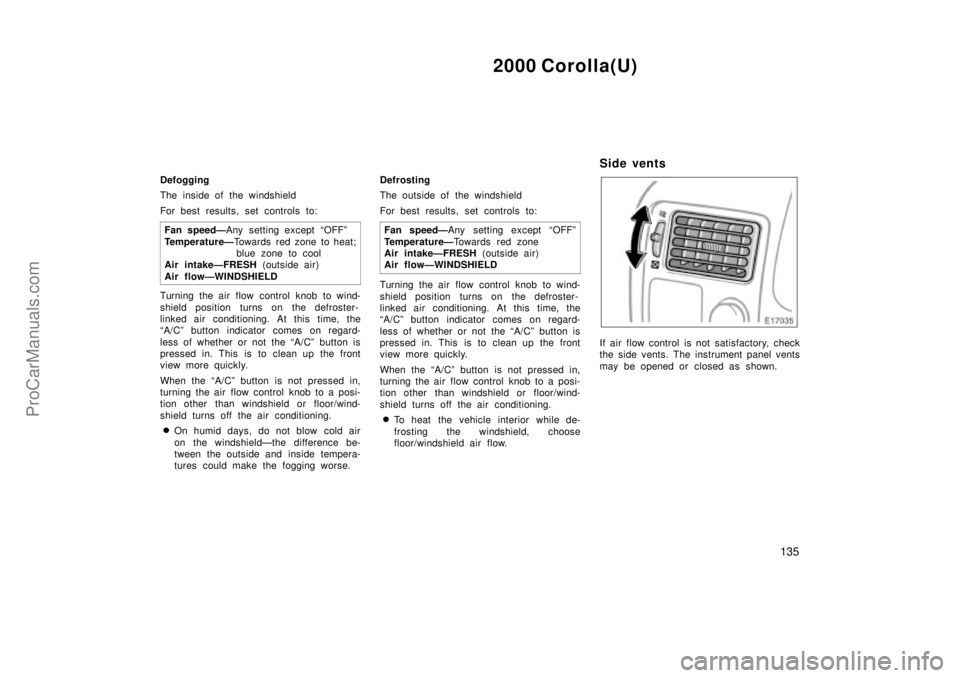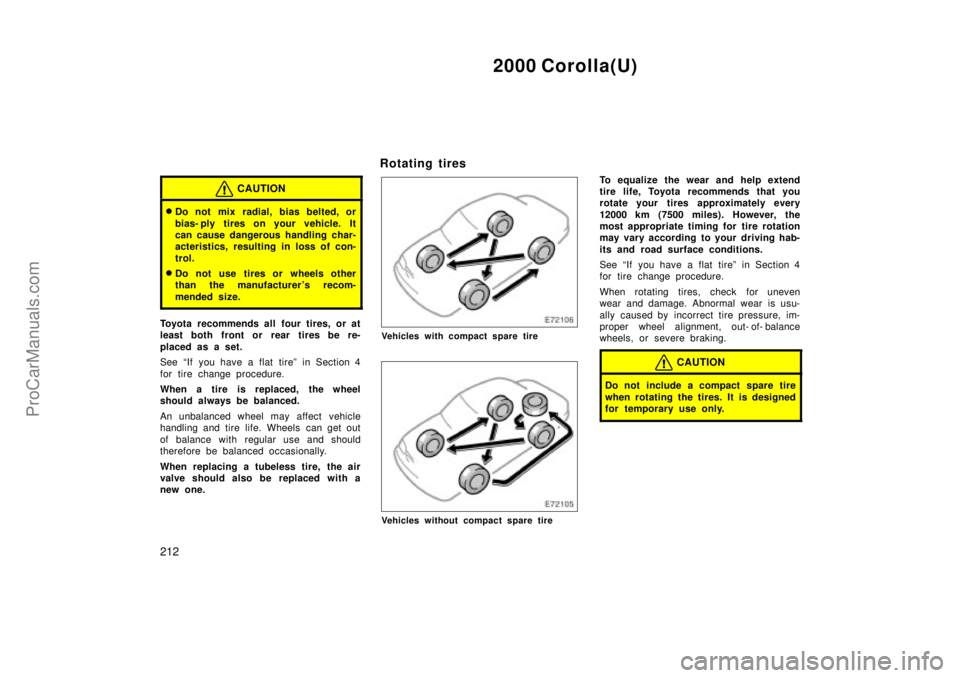Page 208 of 246

2000 Corolla(U)
134�
When driving on dusty roads, close all
windows. If dust thrown up by the ve-
hicle is still drawn into the vehicle after
closing the windows, it is recommended
that the air intake selector be set to
FRESH and the fan speed selector to
any setting except OFFº.
�If following another vehicle on a dusty
road, or driving in windy and dusty
conditions, it is recommended that the
air intake selector be temporarily set to
RECIRCULATE, which will close off the
outside passage and prevent outside
air and dust from entering the vehicle
interior.Heating
For best results, set controls to:
Fan speedÐAny setting except OFFº
TemperatureÐTowards red zone
Air intakeÐFRESH (outside air)
Air flowÐFLOOR
Air conditioningÐOFF
�For quick heating, select recirculated
air for a few minutes. To keep the
windows from fogging, select fresh af-
ter the vehicle interior has been
warmed.
�Press the A/Cº button on for dehumidi-
fied heating.
�Choose floor/windshield air flow to heat
the vehicle interior while defrosting or
defogging the windshield.Air conditioning
For best results, set controls to:
Fan speedÐAny setting except OFFº
TemperatureÐTowards blue zone
Air intakeÐFRESH (outside air)
Air flowÐPANEL
Air conditioningÐON
�For quick cooling, move the air intake
selector to recirculate for a few min-
utes.
Ventilation
For best results, set controls to:
Fan speedÐAny setting except OFFº
TemperatureÐTowards blue zone
Air intakeÐFRESH (outside air)
Air flowÐPANEL
Air conditioningÐOFF
ProCarManuals.com
Page 209 of 246

2000 Corolla(U)
135
Defogging
The inside of the windshield
For best results, set controls to:
Fan speedÐAny setting except OFFº
TemperatureÐTowards red zone to heat;
blue zone to cool
Air intakeÐFRESH (outside air)
Air flowÐWINDSHIELD
Turning the air flow control knob to wind-
shield position turns on the defroster-
linked air conditioning. At this time, the
A/Cº button indicator comes on regard-
less of whether or not the A/Cº button is
pressed in. This is to clean up the front
view more quickly.
When the A/Cº button is not pressed in,
turning the air flow control knob to a posi-
tion other than windshield or floor/wind-
shield turns off the air conditioning.
�On humid days, do not blow cold air
on the windshieldÐthe difference be-
tween the outside and inside tempera-
tures could make the fogging worse.Defrosting
The outside of the windshield
For best results, set controls to:
Fan speedÐAny setting except OFFº
TemperatureÐTowards red zone
Air intakeÐFRESH (outside air)
Air flowÐWINDSHIELD
Turning the air flow control knob to wind-
shield position turns on the defroster-
linked air conditioning. At this time, the
A/Cº button indicator comes on regard-
less of whether or not the A/Cº button is
pressed in. This is to clean up the front
view more quickly.
When the A/Cº button is not pressed in,
turning the air flow control knob to a posi-
tion other than windshield or floor/wind-
shield turns off the air conditioning.
�To heat the vehicle interior while de-
frosting the windshield, choose
floor/windshield air flow.
Side vents
If air flow control is not satisfactory, check
the side vents. The instrument panel vents
may be opened or closed as shown.
ProCarManuals.com
Page 220 of 246

2000 Corolla(U)
202
If you perform maintenance by yourself,
be sure to follow the correct procedure
given in this section.
You should be aware that improper or in-
complete servicing may result in operating
problems.
Performing do- it- yourself maintenance
during the warranty period may affect your
warranty coverage. Read the separate
Toyota Warranty statement for details and
suggestions.
This section gives instructions only for
those items that are relatively easy for an
owner to perform. As explained in Section
6, there are still a number of items that
must be done by a qualified technician
with special tools.
For information on tools and parts for do-
it- yourself maintenance, see Parts and
toolsº.
Utmost care should be taken when work-
ing on your vehicle to prevent accidental
injury. Here are a few precautions that
you should be especially careful to ob-
serve:CAUTION
�When the engine is running, keep
hands, clothing, and tools away
from the moving fan and engine
drive belts. (Removing rings,
watches, and ties is advisable.)
�Right after driving, the engine
compartmentÐthe engine, radiator,
exhaust manifold and spark plug
boots, etc.Ðwill be hot. So be care-
ful not to touch them. Oil, fluids
and spark plugs may also be hot.
�If the engine is hot, do not remove
the radiator cap or loosen the drain
plugs to prevent burning yourself.
�Do not smoke, cause sparks or al-
low open flames around fuel or the
battery. Their fumes are flammable.
�Be extremely cautious when work-
ing on the battery. It contains poi-
sonous and corrosive sulfuric acid.
�Do not get under your vehicle with
just the body jack supporting it. Al-
ways use automotive jack stands or
other solid supports.
�Be sure that the ignition is off if
you work near the electric cooling
fans or radiator grille. With the
ignition on, the electric cooling fans
will automatically start to run if the
engine coolant temperature is high
and/or the air conditioning is on.
�Use eye protection whenever you
work on or under your vehicle
where you may be exposed to flying
or falling material, fluid spray, etc.
�Used engine oil contains potentially
harmful contaminants which may
cause skin disorders such as in-
flammation or skin cancer, so care
should be taken to avoid prolonged
and repeated contact with it. To re-
move used engine oil from your
skin, wash thoroughly with soap
and water.
�Do not leave used oil within the
reach of children.
Do- it- yourself service
precautions
ProCarManuals.com
Page 230 of 246

2000 Corolla(U)
212
CAUTION
�Do not mix radial, bias belted, or
bias- ply tires on your vehicle. It
can cause dangerous handling char-
acteristics, resulting in loss of con-
trol.
�Do not use tires or wheels other
than the manufacturer 's recom-
mended size.
Toyota recommends all four tires, or at
least both front or rear tires be re-
placed as a set.
See If you have a flat tireº in Section 4
for tire change procedure.
When a tire is replaced, the wheel
should always be balanced.
An unbalanced wheel may affect vehicle
handling and tire life. Wheels can get out
of balance with regular use and should
therefore be balanced occasionally.
When replacing a tubeless tire, the air
valve should also be replaced with a
new one.
Rotating tires
Vehicles with compact spare tire
Vehicles without compact spare tire
To equalize the wear and help extend
tire life, Toyota recommends that you
rotate your tires approximately every
12000 km (7500 miles). However, the
most appropriate timing for tire rotation
may vary according to your driving hab-
its and road surface conditions.
See If you have a flat tireº in Section 4
for tire change procedure.
When rotating tires, check for uneven
wear and damage. Abnormal wear is usu-
ally caused by incorrect tire pressure, im-
proper wheel alignment, out- of- balance
wheels, or severe braking.
CAUTION
Do not include a compact spare tire
when rotating the tires. It is designed
for temporary use only.
ProCarManuals.com